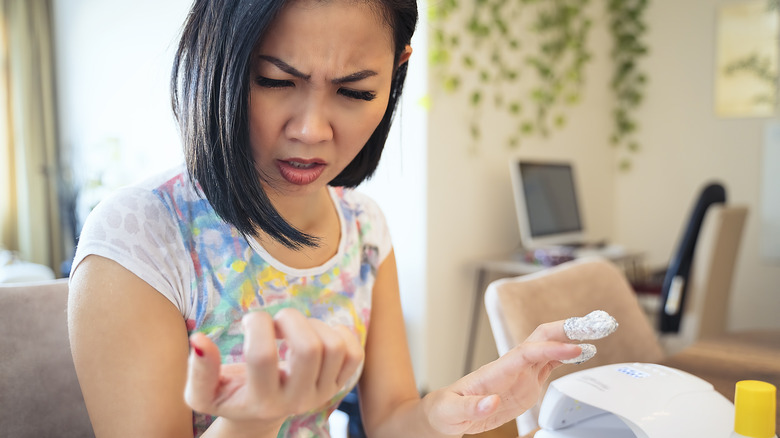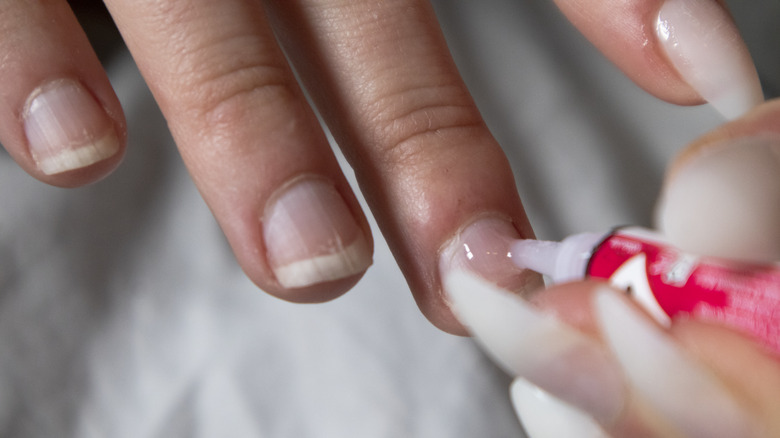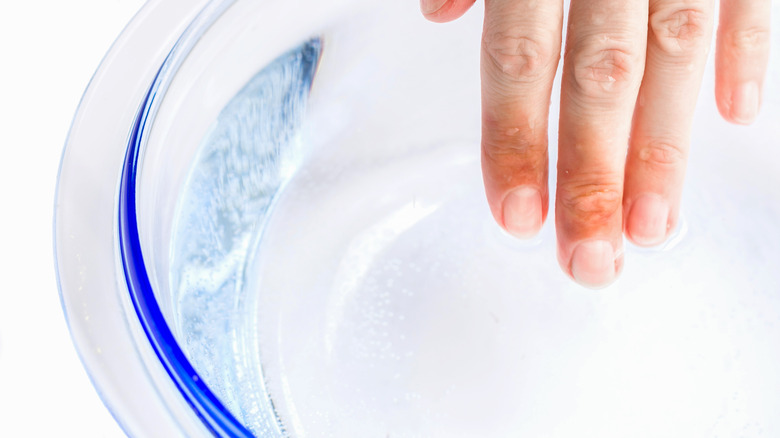Spilled Nail Glue On Your Skin? Here's How To Safely Remove It
Nail glue is sometimes compared to super glue, and for good reason. Both get the job done in terms of keeping things together semi-permanently, and the main ingredient in each is typically cyanoacrylate. This allows its sticking power to go into effect quickly, but despite this key similarity, there are differences between the two — and one of them has to do with your skin.
In most cases, super glue is primarily made up of cyanoacrylate, which is what makes it an extremely strong adhesive. Nail glue, on the other hand, has other ingredients in it — some of them may not only benefit your nails but also ensure that it's safe if it comes into contact with your skin. Super glue is also known for weakening after being exposed to water, whereas nail glue is formulated to tolerate water for longer. Despite what you may have heard about being able to swap one for the other, nail glue will ensure all of those showers and dishwashing won't ruin your manicure.
If you prefer to apply your own false nails at home, you likely already know how irritating it can be to work with nail glue. Whether you apply it in drops or with a brush, there's always a risk of getting it on your skin. Luckily, acetone — something you likely already have if you're a nail enthusiast — can help you remove it.
How to safely remove nail glue from your skin
Perhaps the most bittersweet aspect of nail glue is that it dries quickly. This means that, although it makes false nail application a speedy process, it also makes it nearly impossible to wipe off your skin if you have a mishap. Fortunately, there are a few ways you can remove nail glue from your skin without causing any harm.
If you only spilled a bit of nail glue onto your skin, one simple way to remove it is to soak the area in warm, soapy water for at least 15 minutes, per Healthline. This should begin to loosen the glue from your skin, which will allow you to use a small brush to gently scrub it away.
If you spilled a large amount of nail glue onto your skin or soapy water isn't helping you remove it, you might need to reach for the acetone. Your nail polish remover may already have acetone in it, meaning it can be a viable solution to remove the glue. Soak a cotton ball or cotton pad in the nail polish remover, and apply it to the affected area on your skin. Use your hand to keep it in place — your body heat will help with the removal process. After about 10 minutes, you can begin to scrub away the excess glue. Once it has been removed, don't forget to moisturize, as acetone can easily dry out your skin.
Using moisturizer to remove spilled nail glue from your skin
As soon as nail glue dries on your skin, it can become overwhelmingly uncomfortable. That being said, the urge to immediately remove it might lead you to pull or rip it from your skin. Doing so, however, can cause damage and even create a wound. Gently removing the glue with warm, soapy water or acetone is more effective and safer. Keep in mind that you should also try to remove the nail glue as soon as possible — one 2016 study published in Burns & Trauma indicated that allowing it to sit on your skin for a prolonged period can potentially result in a chemical burn.
If soapy water isn't removing the glue and you don't want to dry out your skin with acetone, you can try to use a moisturizer to lift it. Petroleum jelly, for example, can help loosen its hold once massaged into your skin. Similarly, hand lotion can get the job done — after massaging it into your skin, L'Oréal Paris recommends washing the area with warm water and soap before drying and re-moisturizing it.
In the event that you begin to experience any redness, swelling, or irritation after your spill, don't hesitate to contact your doctor. They can provide assistance, especially in the case of a chemical burn.


